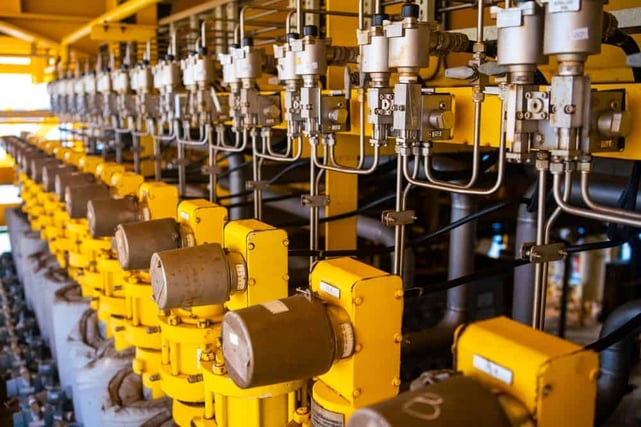Share this
Fabricating High Specification Industrial Gas Manifolds for Corrosive Gasses
by Morgan Zealear on 11/17/22 9:00 AM

Industrial gas manifolds are a simple way to supply the gas to the process from multiple sources or transfer it from a high-pressure gas source to the larger distribution system within a laboratory or industrial facility. These manifolds are usually seen as a part of a source inlet where it is connected to multiple numbers of valves and hoses and regulated by a pressure control system. Given the manifold is always in contact with the fluid, its quality and metallurgical properties should be of prime importance during the selection process.
If reactive or corrosive chemical impurities are present in the gaseous mixture, the gas distribution system at your facility will likely face issues such as leaks and failure. The effect can be exponential at junctions such as the manifolds. Therefore, you will need ultra-high purity and corrosion-resistant industrial gas manifolds for corrosive gases so your operation can run efficiently.
Industrial Gas Manifolds for Corrosive Gases
Industry experts are aware of the dangers of corrosive gases to new and existing pipelines as well as to production and research facilities. In fact, internal corrosion has been listed as one of the major causes of deterioration for gas transmission and distribution systems with causes being contaminants like carbon dioxide, hydrogen sulfide, nitrogen, moisture, or other reactive chemicals. Manifolds, as a connecting agent to different production and distribution lines, are prone to the negative effects of corrosive gases.
%20-%20MS-02-486.pdf.png?width=588&height=455&name=Screenshot%202022-11-13%20at%2023-41-38%20Gas%20Distribution%20Systems%20(MS-02-486%20rev_C%20en-US%20Catalog)%20-%20MS-02-486.pdf.png)
Manifolds have a hollow body with ports that connect to multiple valves and hoses. The highly pressurized gas from one or multiple source cylinders flows through the hose to the manifold where it has direct contact with the metal. When a manifold made of metal such as lower-quality carbon steel grade comes in contact with corrosive gaseous contaminants, it corrodes internally. Corrosion can also be seen when dissimilar metals are used in the manifold assembly. For instance, when a brass hose fitting is used with an aluminum manifold, the corrosive gasses, aided with a moist environment will create galvanic corrosion, eroding the layer of aluminum at the thread and causing the manifold to fail. The corrosion can further lead to:
- Gradual metal loss and decomposition causing blockage of flow path
- Erosion reduces the metal thickness, causing leaks and mechanical failure of the manifold
- Transfer of corrosion beyond the manifold to the metal piping and tubings
- Stress corrosion cracking when the corrosive nature of gas is combined with high pressure and temperature conditions
Only by using the right metallurgical solution for corrosive gases, industrial gas manifolds can serve its critical function.
Metallurgical Solution for High-Quality Industrial Gas Manifold
High-quality metallurgical options for manifolds include various metals that are resistant to corrosive elements of the gas and the high temperature of the process. Manifolds comprised of 304 or 316 stainless steel are most prevalently used as an economic solution to corrosion resistance. The 316 stainless steel manifold, in particular, can resist chemicals including sulfur and chloride, even at high temperatures. Many manufacturers may also choose to perform passivation to remove excess iron on the metal surface and improve its corrosion resistance.
For highly corrosive gases, the addition of chromium and molybdenum content can improve the resistance of the metal. Hastelloy, a nickel alloy, is suitable for such requirements. As a high-chrome and high-moly metal, the Hastelloy manifold provides strong resistance against stress corrosion cracking and localized corrosion.
Fabricating a Corrosion-Resistant System With Swagelok
When selecting the manifold for your gas distribution system, or when assembling the system itself, it is helpful to have expert advice on the different processes and design conditions and the ideal components needed. Swagelok will help you overcome the challenges by providing custom-designed installations and fabrications for your gas distribution facility. Depending on the high- or low-pressure requirement at your facility and the nature of gas at your source inlet, we will identify the ideal material requirement for the supporting component like a manifold with attached valve or tubes.
For gas services, Swagelok provides manifolds with traditional, wafer, and compact body designs and compatible fittings. The manifolds are made of standard 316 stainless steel for high corrosion resistance and can be installed to meet your facility’s requirements. The Inconel® or Hastelloy components with industrial gas manifolds for corrosive gases are sure to ensure the safety and reliability of the gas distribution system at your facility.
With Swagelok’s high-quality products and services at the core, the safety of your personnel and process control of operation at your Northern California facility is guaranteed.
To learn more about Swagelok Northern California’s and how our industrial gas manifolds for corrosive gases can ensure the safety of your facility, contact our team today by calling 510-933-6200.
 Morgan Zealear | Product Engineer – Assembly Services
Morgan Zealear | Product Engineer – Assembly Services
Morgan holds a B.S. in Mechanical Engineering from the University of California at Santa Barbara. He is certified in Section IX, Grab Sample Panel Configuration, and Mechanical Efficiency Program Specification (API 682). He is also well-versed in B31.3 Process Piping Code. Before joining Swagelok Northern California, he was a Manufacturing Engineer at Sierra Instruments, primarily focused on capillary thermal meters for the semiconductor industry (ASML).
Share this
- Archive (465)
- Assembly Services (207)
- About (100)
- Seal Support Systems (96)
- Best Practices (88)
- Training Services (74)
- Fittings (51)
- Semiconductor Applications (49)
- Hoses and Flexible Tubing (47)
- Regulators (44)
- Tubing (42)
- Grab Sampling Systems (32)
- Sampling Systems (32)
- Gas Systems (30)
- Services (30)
- Downloads (29)
- Valves (24)
- Application Support (18)
- Orbital Welding (17)
- Case Studies (13)
- Steam Systems (13)
- Frequently Asked Questions (12)
- Tools (12)
- Measurement Devices (7)
- Subsystems (6)
- Thermal Management (6)
- September 2023 (1)
- August 2023 (2)
- June 2023 (1)
- March 2023 (3)
- February 2023 (3)
- January 2023 (4)
- December 2022 (4)
- November 2022 (4)
- October 2022 (4)
- September 2022 (1)
- August 2022 (3)
- July 2022 (2)
- June 2022 (4)
- May 2022 (1)
- April 2022 (2)
- March 2022 (1)
- February 2022 (2)
- January 2022 (3)
- December 2021 (1)
- November 2021 (6)
- October 2021 (6)
- September 2021 (8)
- August 2021 (4)
- July 2021 (3)
- June 2021 (6)
- May 2021 (6)
- April 2021 (7)
- March 2021 (5)
- February 2021 (4)
- January 2021 (6)
- December 2020 (5)
- November 2020 (6)
- October 2020 (6)
- September 2020 (8)
- August 2020 (7)
- July 2020 (8)
- June 2020 (8)
- May 2020 (6)
- April 2020 (9)
- March 2020 (7)
- February 2020 (10)
- January 2020 (21)
- December 2019 (23)
- November 2019 (21)
- October 2019 (22)
- September 2019 (21)
- August 2019 (22)
- July 2019 (23)
- June 2019 (20)
- May 2019 (23)
- April 2019 (22)
- March 2019 (21)
- February 2019 (20)
- January 2019 (21)
- December 2018 (14)
- November 2018 (19)
- October 2018 (23)
- September 2018 (17)
- August 2018 (29)
- July 2018 (11)
- June 2018 (6)
- May 2018 (5)
- April 2018 (4)
- March 2018 (5)
- February 2018 (3)
- January 2018 (3)
- December 2017 (2)
- November 2017 (4)
- October 2017 (3)
- September 2017 (2)
- August 2017 (6)
- July 2017 (4)
- June 2017 (4)
- May 2017 (4)
- April 2017 (3)
- March 2017 (4)
- February 2017 (3)
- January 2017 (3)
- December 2016 (3)
- November 2016 (3)
- October 2016 (3)
- September 2016 (5)
- August 2016 (5)
- July 2016 (4)
- June 2016 (5)
- May 2016 (3)
- April 2016 (4)
- March 2016 (5)
- February 2016 (11)
- January 2016 (1)
- December 2015 (3)
- November 2015 (4)
- October 2015 (3)
- September 2015 (4)
- August 2015 (4)
- July 2015 (8)
- June 2015 (5)
- May 2015 (3)
- April 2015 (4)
- March 2015 (4)
- February 2015 (3)
- January 2015 (4)
- December 2014 (2)
- November 2014 (3)
- October 2014 (4)
- September 2014 (4)
- August 2014 (4)
- July 2014 (5)
- June 2014 (4)
- May 2014 (4)
- April 2014 (5)
- March 2014 (4)
- February 2014 (3)
- January 2014 (4)
- December 2013 (5)
- November 2013 (3)
- October 2013 (4)
- September 2013 (3)
- August 2013 (5)
- July 2013 (5)
- June 2013 (5)
- May 2013 (3)
- April 2013 (6)
- March 2013 (4)
- February 2013 (4)
- January 2013 (8)
- December 2012 (4)
- November 2012 (6)
- October 2012 (6)
- September 2012 (4)
- August 2012 (4)
- July 2012 (4)
- June 2012 (4)

.webp?width=210&height=70&name=StickyLogo%20(5).webp)